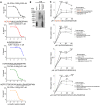Autoimmune response to transthyretin in juvenile idiopathic arthritis
- PMID: 26973882
- PMCID: PMC4784708
- DOI: 10.1172/jci.insight.85633
Autoimmune response to transthyretin in juvenile idiopathic arthritis
Abstract
Juvenile idiopathic arthritis (JIA) is the most common pediatric rheumatological condition. Although it has been proposed that JIA has an autoimmune component, the autoantigens are still unknown. Using biochemical and proteomic approaches, we identified the molecular chaperone transthyretin (TTR) as an antigenic target for B and T cell immune responses. TTR was eluted from IgG complexes and affinity purified from 3 JIA patients, and a statistically significant increase in TTR autoantibodies was observed in a group of 43 JIA patients. Three cryptic, HLA-DR1-restricted TTR peptides, which induced CD4+ T cell expansion and IFN-γ and TNF-α production in 3 out of 17 analyzed patients, were also identified. Misfolding, aggregation and oxidation of TTR, as observed in the synovial fluid of all JIA patients, enhanced its immunogenicity in HLA-DR1 transgenic mice. Our data point to TTR as an autoantigen potentially involved in the pathogenesis of JIA and to oxidation and aggregation as a mechanism facilitating TTR autoimmunity.
Figures








Similar articles
-
Novel self-epitopes derived from aggrecan, fibrillin, and matrix metalloproteinase-3 drive distinct autoreactive T-cell responses in juvenile idiopathic arthritis and in health.Arthritis Res Ther. 2006;8(6):R178. doi: 10.1186/ar2088. Arthritis Res Ther. 2006. PMID: 17129378 Free PMC article.
-
Next-Generation Sequencing Reveals Restriction and Clonotypic Expansion of Treg Cells in Juvenile Idiopathic Arthritis.Arthritis Rheumatol. 2016 Jul;68(7):1758-68. doi: 10.1002/art.39606. Arthritis Rheumatol. 2016. PMID: 26815131 Free PMC article.
-
Elevated concentrations of monocyte derived cytokines in synovial fluid of children with enthesitis related arthritis and polyarticular types of juvenile idiopathic arthritis.J Rheumatol. 2005 Jul;32(7):1349-53. J Rheumatol. 2005. PMID: 15996076
-
The pathogenesis of oligoarticular/polyarticular vs systemic juvenile idiopathic arthritis.Autoimmun Rev. 2011 Jun;10(8):482-9. doi: 10.1016/j.autrev.2011.02.001. Epub 2011 Feb 12. Autoimmun Rev. 2011. PMID: 21320644 Review.
-
Autoantibodies in the Pathogenesis, Diagnosis, and Prognosis of Juvenile Idiopathic Arthritis.Front Immunol. 2019 Jan 14;9:3168. doi: 10.3389/fimmu.2018.03168. eCollection 2018. Front Immunol. 2019. PMID: 30693002 Free PMC article. Review.
Cited by
-
Transthyretin deposition promotes progression of osteoarthritis.Aging Cell. 2017 Dec;16(6):1313-1322. doi: 10.1111/acel.12665. Epub 2017 Sep 22. Aging Cell. 2017. PMID: 28941045 Free PMC article.
-
Non-mutational neoantigens in disease.Nat Immunol. 2024 Jan;25(1):29-40. doi: 10.1038/s41590-023-01664-1. Epub 2024 Jan 2. Nat Immunol. 2024. PMID: 38168954 Free PMC article. Review.
-
A Novel Biological Role for Peptidyl-Arginine Deiminases: Citrullination of Cathelicidin LL-37 Controls the Immunostimulatory Potential of Cell-Free DNA.J Immunol. 2018 Apr 1;200(7):2327-2340. doi: 10.4049/jimmunol.1701391. Epub 2018 Feb 23. J Immunol. 2018. PMID: 29475987 Free PMC article.
-
Crinophagic granules in pancreatic β cells contribute to mouse autoimmune diabetes by diversifying pathogenic epitope repertoire.Nat Commun. 2024 Sep 27;15(1):8318. doi: 10.1038/s41467-024-52619-5. Nat Commun. 2024. PMID: 39333495 Free PMC article.
-
Involvement of Akt in mitomycin C and its analog triggered cytotoxicity in MCF-7 and K562 cancer cells.Chem Biol Drug Des. 2018 Dec;92(6):2022-2034. doi: 10.1111/cbdd.13374. Epub 2018 Sep 11. Chem Biol Drug Des. 2018. PMID: 30091208 Free PMC article.
References
Grants and funding
- R01 AI038996/AI/NIAID NIH HHS/United States
- P30 DK078392/DK/NIDDK NIH HHS/United States
- R01 AI048833/AI/NIAID NIH HHS/United States
- R56 AI038996/AI/NIAID NIH HHS/United States
- R01 AG045223/AG/NIA NIH HHS/United States
- S10 RR019352/RR/NCRR NIH HHS/United States
- R01 AI137198/AI/NIAID NIH HHS/United States
- P01 AR048929/AR/NIAMS NIH HHS/United States
- P30 AR070549/AR/NIAMS NIH HHS/United States
- P30 DK090971/DK/NIDDK NIH HHS/United States
- R37 AI038996/AI/NIAID NIH HHS/United States
- P30 CA013330/CA/NCI NIH HHS/United States
- P30 AR047363/AR/NIAMS NIH HHS/United States
- P01 AG031782/AG/NIA NIH HHS/United States
LinkOut - more resources
Full Text Sources
Other Literature Sources
Research Materials
Miscellaneous

